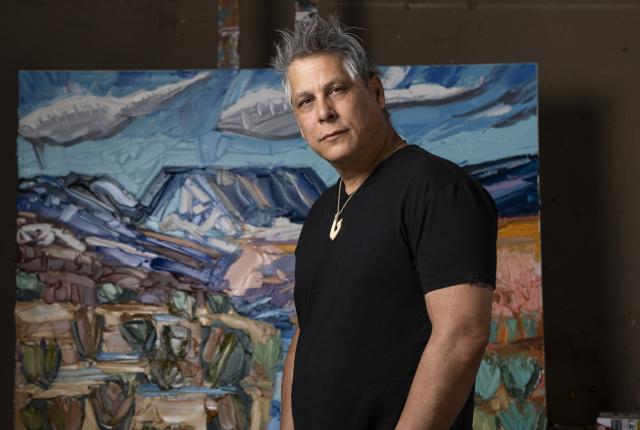This essay is one of 70 by mostly Pueblo people—artists, writers, historians, scientists, and political leaders—collected for "Grounded in Clay: The Spirit of Pueblo Pottery," an exhibition that runs through May 29, 2023, at the Museum of Indian Arts & Culture. For an insider's look at the exhibit, read "Pueblo Pottery Exhibit Breaks the Mold," by Kate Nelson.
AS THE RAILROAD BRINGS white American tourists into contact with previously isolated Río Grande Pueblo communities, the mono art form is born. These figurines take the form of carnival strongmen, bearded ladies, circus performers, sheriffs, and mental snapshots of other characters from the world outside the village. Even among the works of the eccentric Cochiti polychrome potters, the mono stands out as unique. Its aesthetic and material basis lies in Cochiti polychrome ceramics, but the mono* does something that historical pottery does not; it critiques mainstream white American culture with humor and satire.
This particular mono has a beard and an elongated body, and wears a vest with a biomorphic motif, pin-striped britches, and lace-up boots. It is executed in traditional Cochiti polychrome materials—Native clay, white and La Bajada red iron-oxide slips, and bee-plant carbon-black paint—and is pit-fired.
Imagine it is the turn of the last century and you have spent your entire life in the small area that stretches from Santo Domingo Pueblo (Kewa) to Santa Fe. My father told stories of his youth, when he would travel with his father by covered wagon along the dirt road that scales La Bajada Hill and traverses Las Campanas into Santa Fe. It was a two-day trip with an overnight camp in the Las Campanas area, and in the morning they would brew black coffee and cook fresh tortillas over the campfire. Travel through this area is slow, considered, deliberate. My father, Santiago Romero, will later paint Dunn School–type** watercolors of these trips that are alive with the languid light, remote space, and glacial sense of time.
The first biplane to be seen in Cochiti lands on the baseball field. The pilot is a friend of Grandpa’s and takes him on a short flight out of the village. And then comes the iron-horse railroad on steel tracks, running through Cochiti and stopping at the Santo Domingo Trading Post. The physical, spiritual, and cultural space of the village, which has been largely intact since the Pueblo Revolt of 1680, has been penetrated by the modern industrial world.
It is at this time of radical change that the artform of the mono appears. The mono is essentially a Cochiti perspective on the people and culture of the outside world, and Cochiti artists create these figurines to sell to those people alongside traditional polychrome pottery. The monos represent the curiosity of the artists who make them, also their fear, humor, trepidation, and financial need. The train is the conduit for transmission of the figurines as ethnographic curios at trading posts along the railroad tracks. Tourists are used as a canvas onto which a uniquely Indigenous worldview is projected, one that expresses feelings of anxiety about a changing world.
*Mono is Spanish for “monkey.”
**In 1932, Dorothy Dunn established the Studio, a painting program for Native students, at the Santa Fe Indian School.
Read More: Don't miss essays by Diego Medina, Claudia Mitchell, Evone "Snowflake" Martinez, Melissa Talachy Romero, and Dominique Toya.



